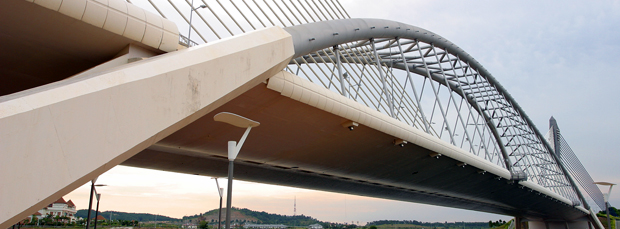What are stay cables?
What is the first thing that you think about when you see a cable-stayed structure? Is it perhaps the strength of the technology supporting that structure – or maybe it is the sheer elegance that stay cables bring to the landscape or city skyline? Or maybe you wonder what stay cables actually are and what it is that they do? Learn more about stay cables and why BBR has been in the forefront of this industry for more than 50 years!
 |
Q: What are stay cables?
A: Most simply explained, they are cables – of strand, wire or carbon – which are used to transfer structural load or to hold a structure in position without using piers, columns or other supports.
The cables do this by channeling, or distributing, the structure’s weight – and the ‘live loads’ generated during normal everyday usage – through another structural element, such as a bridge pylon. Cable-stayed bridges, for example, have a great potential when it comes to meeting the increasing demand for long span structures. Their advantages lie mainly in increased aerodynamic stability, reduced costs for the abutments and faster, easier construction and lightweight overall structures. However, the most important factor in ensuring the durability and performance of a cable-stayed bridge is the stay cable system.
Q: What types of stay cable are there?
A: There are three basic types – parallel steel strand, wire and carbon. In fact, BBR invented strand and carbon stay cables and carried out the world’s first projects using high fatigue resistant wire, strand and carbon stay cables – we are the company who started it all!
Wire stay cables are generally prefabricated and strand stay cables are more commonly assembled on site using a strand-by-strand installation method, thus the choice of the suitable cable system for a particular project depends on many factors.
It is often considered that prefabricated cables are best suited to smaller bridges. On site fabricated stay cables are usually suited to longer spans. However, the designer together with the specialist stay cable company must evaluate each project individually. Erection requirements, as well as the overall economics, should always be considered.
Both wire and strand type cable systems are today’s solutions of choice for modern cable-stayed structures. Over the years, the ultimate tensile strength of the wires and strands has gradually been increased and will further be increased. Furthermore, the corrosion protection systems have been enhanced to enhance the long-term durability of stay cables.
Carbon may be considered for ultra long span bridges due to its low self-weight.
Q: What are the key factors to achieve a desired 100-year design life?
A: Stay cables are subjected to high tensile forces and, given the fact that cable supported structures are typically very light structures, the stay cables are subjected to high stress variations, thus high fatigue resistant stay cables are of great importance. In addition, excellent corrosion protection features, replaceability of cables, installation expertise and further key factors must be observed to achieve a 100-year design life.
Targeting a 100-year life requires a high level of corrosion protection for the cables – making directly exposed cable surfaces such as locked coil and bar cables obsolete for anything other than architectural applications. Additional considerations should be given to the replaceability of the key components.
An important lesson learned on strand as well as wire stay cables – especially by owners and contractors – is that cable installation is the work of the specialist who also provides the stay cable technology. Practices of the past, where only supply of fully or partially prefabricated stay cables has been contracted to the system suppliers must be avoided.
Even newly constructed cable stayed bridges have experienced quite severe vibrations which may result in failures of cables. A careful evaluation is therefore always required and countermeasures, such as dampers are highly recommended.
Care should also be taken when designing long cables. Effects, such as the sag of the cable on the effective damping, rotational bending stresses and other effects can only be appreciated for long cables.
Q: What are the latest international specifications for stay cables?
A: Today, the state-of-the-art and internationally versatile recommendation for stay cables is fib – International Federation for Structural Concrete, Bulletin 30, Acceptance of Stay Cable Systems using Prestressing Steels. Most modern stay cable systems have been developed and tested to these provisions including axial fatigue and subsequent tensile as well as leak tightness tests.
Specifications for stay cables have, in the past, always been covered by guidelines and recommendations, historically the most popular has been PTI – Post-tensioning Institute (USA), Recommendation for Stay Cable Design, Testing and Installation.
There are other less common and minor national recommendations such as, for example, from CIP (Setra) in France. National recommendations cover only locally available materials and construction practices and are limited to the knowledge of local suppliers, which lead to an unjustified and incorrect treatment of stay cable systems as a whole. To ensure international and legally correct tenders, such national recommendations should not be considered – they may occasionally only be used as complementary guidelines.
HiAm CONA
Stay Cable System - Elegance and Strength
See our Downloads page
CONNAECT 2010
Fourth Edition of the Magazine of the Global BBR Network of Experts
See our Downloads page
BBR world first applications
1960 – Wire Stay Cable
The first bridge to be built using parallel wire cables was the pedestrian Schillersteg Bridge across the Schillerstrasse in Stuttgart, Germany.
1972 – Strand Stay Cable
The world's first application of BBR HiAm parallel strand stay cables was for the cable-supported membrane roof structure at Olympic Stadium in Munich.
1994 – Carbon Stay Cable
The Storchenbrücke in Winterthur, Switzerland – crossing the major east-west axis of the Swiss Federal Railway Network – was the world’s first bridge to be constructed using carbon stay cable technology.



